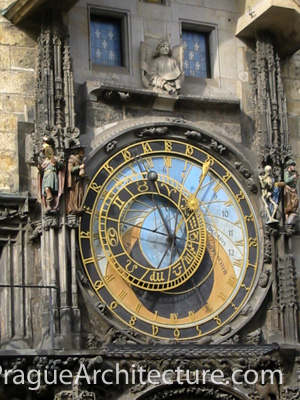    
| |
|---|---|
| Home :: Building Database :: Forum | You are here  Architecture Architecture  Prague Prague  The Old Town The Old Town 
|
    
| |
|---|---|
| Home :: Building Database :: Forum | You are here  Architecture Architecture  Prague Prague  The Old Town The Old Town 
|
 Photograph © Wayne Lorentz/Artefaqs Corporation  Photograph © Wayne Lorentz/Artefaqs Corporation  Scroll down for more pictures Scroll down for more pictures   Photograph © Wayne Lorentz/Artefaqs Corporation  Photograph © Wayne Lorentz/Artefaqs Corporation  Photograph © Wayne Lorentz/Artefaqs Corporation
|
Astronomical Clock

 Staroměstské náměsti, Prague, Hlavni Město Praha Czech Republic Staroměstské náměsti, Prague, Hlavni Město Praha Czech Republic  Print this page • Print this page •  Share this page
Share this page

Rarely is a timepiece worthy of such attention. But as in the case of Big Ben, the Astronomical Clock is a amazing piece of machinery that has become part of the collective soul of the community. Sound like an overstatement? Consider the fact that when it was rebuilt in 1490 by a man named Hanu, the city council ordered him blinded so he could never create a better timepiece. It sounds like an urban legend, but life was rough in the 15th century, especially for people skilled with their hands and their minds. The mentality of the age is reflected in the fact that the sun on the clock's face rotates around the Earth, and not the other way around. There are other ways the time the clock was created are captured in the way it tells time. The numbers on the clock face are both Roman and Medieval Arabic, which is purer and related to trigonometry much more closely than the rounded figures we used today. The day also begins with sunset instead of midnight, consistent with Old Bohemian standards. Since the clock is outside, unless there's an eclipse you already have a pretty good idea if it's day or night, but the clock still uses colors to symbolize the passage of day and night. The clock also shows the sun and moon moving through the different constellations. All of this is amazing in a 600-year-old timepiece, but the real show is still to come. At the top of each hour, the clock puts on a show. On the right, a skeleton representing death turns over an hourglass held in one hand. With the other hand he pulls a rope and the doors over the main clock face open revealing a procession of mechanical apostles led by Saint Paul. A rooster crows and the figure of a Turk (representing lust), a figure representing Vanity, and a moneylender (representing greed) animate. It's been a crowd pleaser since the 15th century. Sponsored by: Towrs: The architecture site you help build Quick Facts
Rate This Monument method='post' action='/Building.php?ID=100#Rate'>Current rating:  60% name='Rating' id='Rating' value='Praise' class='Plain'> name='Rating' id='Rating' value='Raze' class='Plain'> 60% name='Rating' id='Rating' value='Praise' class='Plain'> name='Rating' id='Rating' value='Raze' class='Plain'>Your Thoughts  There are no comments. You can be the first to add your thoughts to this page.  |
 PAI Community PAI Community
|
 PAI Extras PAI Extras
|
 PAI Tools PAI Tools
|
 PAI Sister Sites PAI Sister Sites
|
|---|---|---|---|